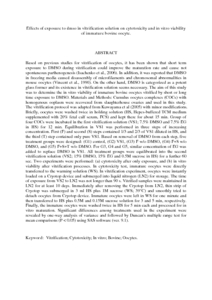Citation
H., Hajarian and Haron, Abd Wahid and Othman, Abas Mazni and Yusoff, Rosnina and M., Daliri and M., Dashtizad
(2010)
Effects of exposure to dmso in vitrification solution on cytotoxicity and in vitro viability of immature bovine oocyte.
Reproductive BioMedicine Online, 20 (Suppl.).
pp. 37-38.
ISSN 1472-6483; ESSN:1472-6491
Abstract
Based on previous studies for vitrification of oocytes, it has been shown that short term exposure to DMSO during vitrification could improve the maturation rate and cause not spontaneous parthenogenesis (Isachenko et al., 2006). In addition, it was reported that DMSO in freezing media caused disassembly of microfilaments and chromosomal abnormalities in mouse oocytes (Vincent et al., 1990). On the other hand, DMSO is categorized as a potent glass former and its existence in vitrification solution seems necessary. The aim of this study was to determine the in vitro viability of immature bovine oocytes vitrified by short or long time exposure to DMSO. Materials and Methods: Cumulus oocytes complexes (COCs) with homogenous ooplasm were recovered from slaughterhouse ovaries and used in this study. The vitrification protocol was adapted from Kuwayama et al (2005) with minor modifications. Briefly, oocytes were washed twice in holding solution (HS, Hepes-buffered TCM medium supplemented with 20% fetal calf serum, FCS) and kept there for about 15 min. Group of four COCs were incubated in the first vitrification solution (VS1; 7.5% DMSO and 7.5% EG in HS) for 12 min. Equilibration in VS1 was performed in three steps of increasing concentration. First (F) and second (S) steps contained 1/3 and 2/3 of VS1 diluted in HS, and the third (T) step contained only pure VS1. Based on removal of DMSO from each step, five treatment groups were designed: (G1) control, (G2) VS1, (G3) F w/o DMSO, (G4) F+S w/o DMSO, and (G5) F+S+T w/o DMSO. For G3, G4 and G5, similar concentration of EG was added to replace DMSO in VS1. All treatment groups were equilibrated into the second vitrification solution (VS2; 15% DMSO, 15% EG and 0.5M sucrose in HS) for a further 60 sec. Two experiments were performed: (a) cytotoxicity after only exposure, and (b) in vitro viability after vitrification processes. In cytotoxicity test, immature oocytes were directly transferred to the warming solution (WS). In vitrification experiment, oocytes were instantly loaded on a Cryotop device and submerged into liquid nitrogen (LN2) for storage. The time of exposure from VS2 to LN2 was not longer than 90 s. Vitrified samples were maintained in LN2 for at least 10 days. Immediately after removing the Cryotop from LN2, thin strip of Cryotop was submerged in 3 ml HS plus 1M sucrose (WS; 39°C) and smoothly tried to detach oocytes from Cryotop device. Immature oocytes were left in WS for one minute and then transferred to HS plus 0.5M and 0.15M sucrose solution for 3 and 5 min, respectively. Finally, the immature oocytes were washed twice in HS for 5 min each and processed for in vitro maturation. Significant differences among treatments used in the experiment were revealed by one-way analysis of variance and followed by Duncan's multiple range test for mean comparisons (P < 0.05) using SAS software (ver. 9.1).
Download File
![[img]](http://psasir.upm.edu.my/14370/1.hassmallThumbnailVersion/Effects%20of%20exposure%20to%20dmso%20in%20vitrification%20solution%20on%20cytotoxicity%20and%20in%20vitro%20viability%20of%20immature%20bovine%20oocyte.pdf)  Preview |
|
PDF (Abstract)
Effects of exposure to dmso in vitrification solution on cytotoxicity and in vitro viability of immature bovine oocyte.pdf
Download (87kB)
| Preview
|
|
Additional Metadata
Actions (login required)
 |
View Item |

